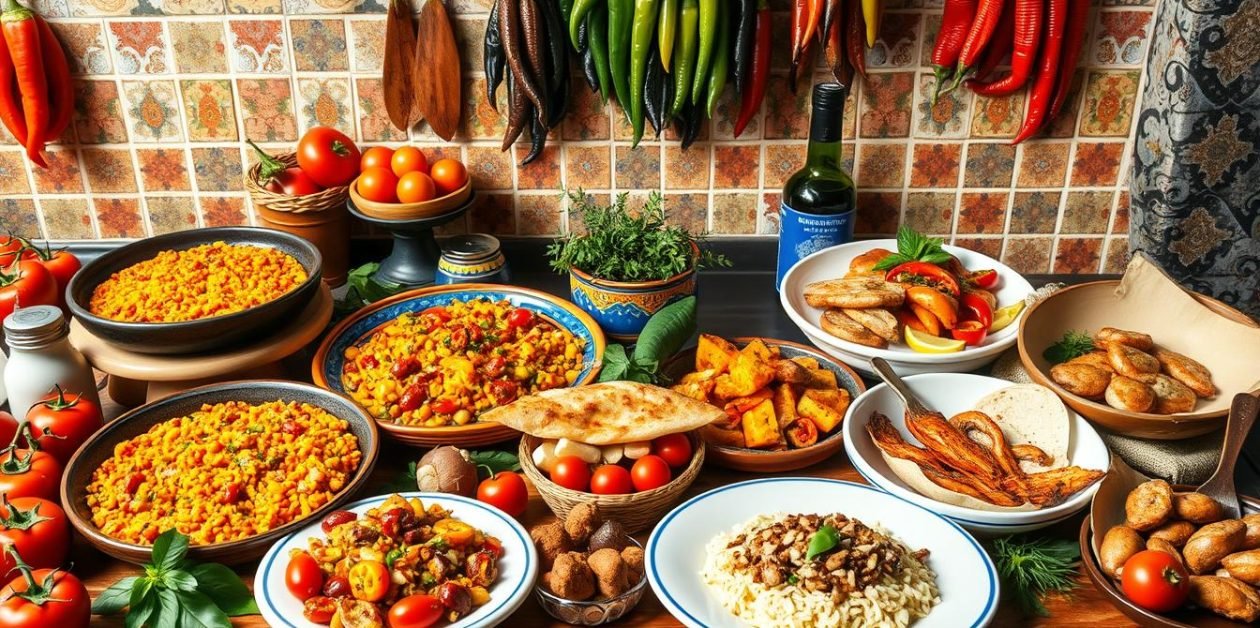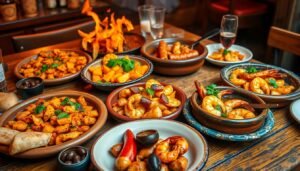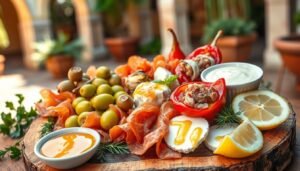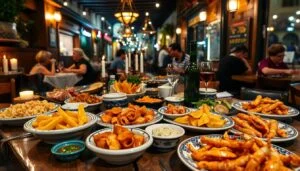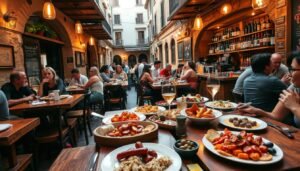Spain is a big deal in food, making over 45% of the world’s olive oil. This is a big fact that shows how much Spain loves food. We will look at the different foods from all over Spain. Each place has its own special tastes, ingredients, and old traditions.
From Andalusia’s sunny beaches to Castilla y León’s green mountains, Spain’s land is perfect for food. In this article, we’ll dive into Regional Spanish Cuisines, Spanish Gastronomy, and Regional Spanish Food. We’ll explore the Authentic Spanish Dishes, Traditional Spanish Cooking, and Spanish Culinary Traditions that people love all over the world.
Key Takeaways
- Spain is a big deal in food, making over 45% of the world’s olive oil.
- Each region of Spain has its own special Regional Spanish Cuisines and Local Spanish Specialties.
- The different Regional Spanish Flavors and Spanish Provincial Cuisine come from Spain’s long and rich Iberian Culinary Heritage.
- From the North’s seafood to the South’s famous Traditional Spanish Cooking, Spain’s Regional Spanish Food is full of flavors.
- Trying Spain’s Authentic Spanish Dishes and Spanish Culinary Traditions is a way to understand Spain’s lively Spanish Gastronomy.
Savoring the Essence: Spain’s Culinary Heritage
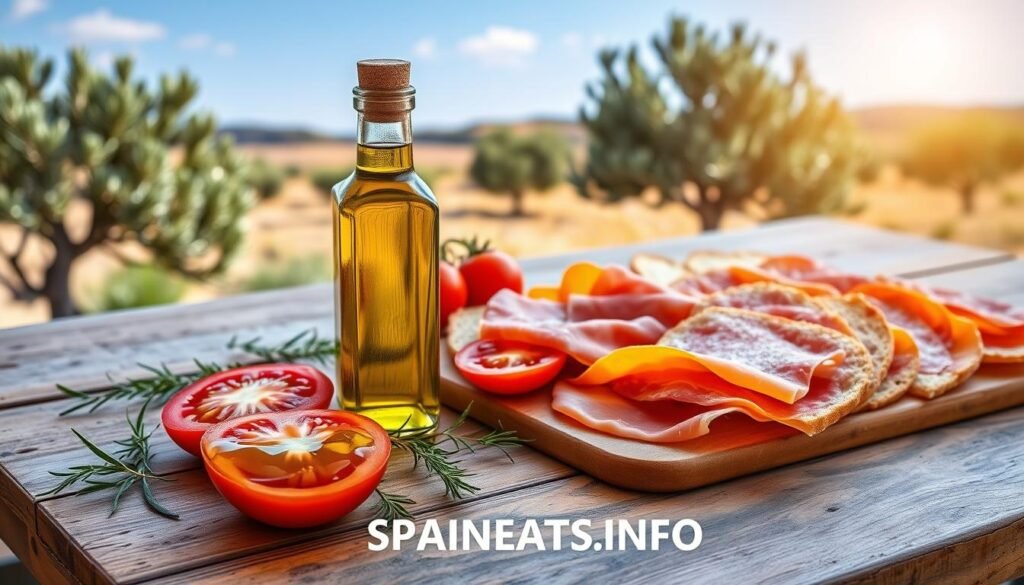
Spain’s food scene is filled with tradition and new ideas. At its core, the love for Spanish Olive Oil and Spanish Jamon stands out.
Olive Oil: The Golden Liquid of Spanish Gastronomy
Olive oil is very special in Spanish food. Spain makes the most olive oil in the world. The green Andalusia Olive Groves are where this oil comes from.
Olives are carefully picked and pressed to make the best Olive Oil in Spanish Cuisine. People in Spain use Olive Oil Cooking Techniques to make food taste better. They use it on salads, with veggies, or for frying.
The Art of Jamon: Spain’s Cherished Cured Ham Tradition
Talking about Spanish food isn’t complete without Spanish Jamon. Making ham is a big deal in Spain. Jamon Iberico and Jamon Serrano are the best.
These Cured Meats in Spanish Cuisine are aged for a long time. This makes them taste amazing. People in Spain love their Jamon Iberico and Jamon Serrano. They see these meats as a big part of their food history.
| Olive Oil | Jamon |
|---|---|
|
|
“Olive oil and jamon are the cornerstones of Spanish cuisine, celebrating the country’s rich culinary heritage and the dedication of its people to producing the finest ingredients.”
Flavors of the North: Coastal Delights and Mountain Treasures
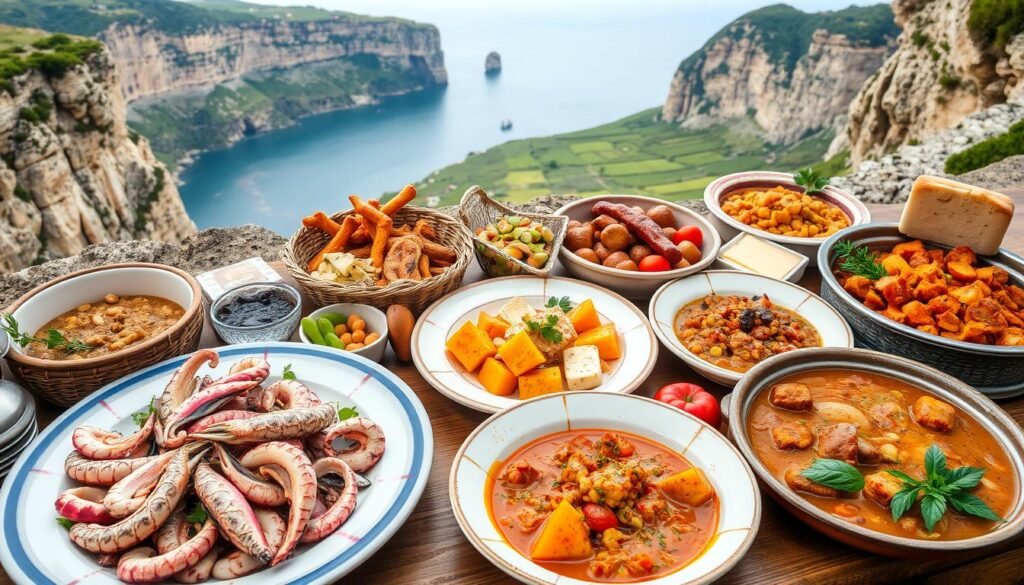
Northern Spain is a mix of mountains and sea. It has beautiful landscapes and tasty foods. From Asturias‘ green fields to La Rioja‘s vineyards, it’s a food lover’s dream.
The coast is full of seafood like hake and mussels. Percebes (goose barnacles) are famous here. Inland, valleys grow fresh veggies and make Idiazabal cheese. Fishing villages cook up tasty stews like marmitako.
| Dish | Region | Description |
|---|---|---|
| Hake | Coastal Northern Spain | A popular and delicious white fish found in abundance in the waters of the Bay of Biscay. |
| Mussels | Coastal Northern Spain | Bountiful supplies of these flavorful bivalves are harvested from the region’s pristine coastlines. |
| Pimientos de Padrón | Asturias | Small, green peppers that are often fried and served as a popular tapa, with a delightful mix of sweet and spicy flavors. |
| Idiazabal Cheese | Basque Country | A semi-hard, sheep’s milk cheese with a rich, nutty flavor, often smoked for an added depth of taste. |
| Marmitako | Basque Country | A hearty stew made with tuna, potatoes, onions, and peppers, reflecting the region’s coastal and mountain influences. |
Northern Spain’s beauty and food leave a mark on visitors. It’s a special journey through Northern Spanish Cuisine, Cantabrian Mountains, and Bay of Biscay.
“The Asturias Gastronomy and La Rioja Wines show the region’s love for food. They highlight the best of Basque Culinary Traditions.
Galicia: Where the Sea Meets the Land
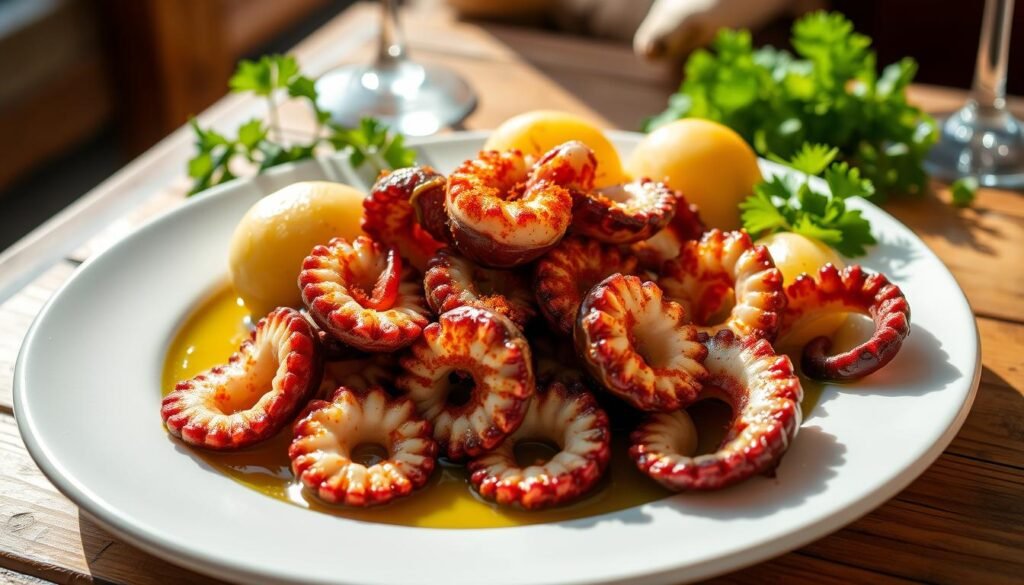
Galicia is in the northwest of Spain. It’s where the sea meets the land. This area is known for its seafood and rich food traditions.
Pulpo a la Gallega: A Symbol of Galician Seafood Mastery
The Pulpo a la Gallega is a famous octopus dish from Galicia. It’s boiled octopus with olive oil, paprika, and sea salt. This dish shows how much Galicians love the sea.
Galicia has more than just Pulpo a la Gallega. You can find tasty seafood like percebes and mussels. The cool Atlantic waters make it perfect for seafood lovers.
But there’s more to Galician food than seafood. They also have dairy, meat, and Albariño wines. The Rías Baixas region is famous for its wine, which goes great with local dishes.
| Galician Cuisine Highlights | Galician Wine Albariño |
|---|---|
|
|
Galicia’s food is all about the sea and the land. It’s a great place for food lovers to explore Spain’s different foods.
Basque Country: Pintxos and Txakoli, A Culinary Embrace
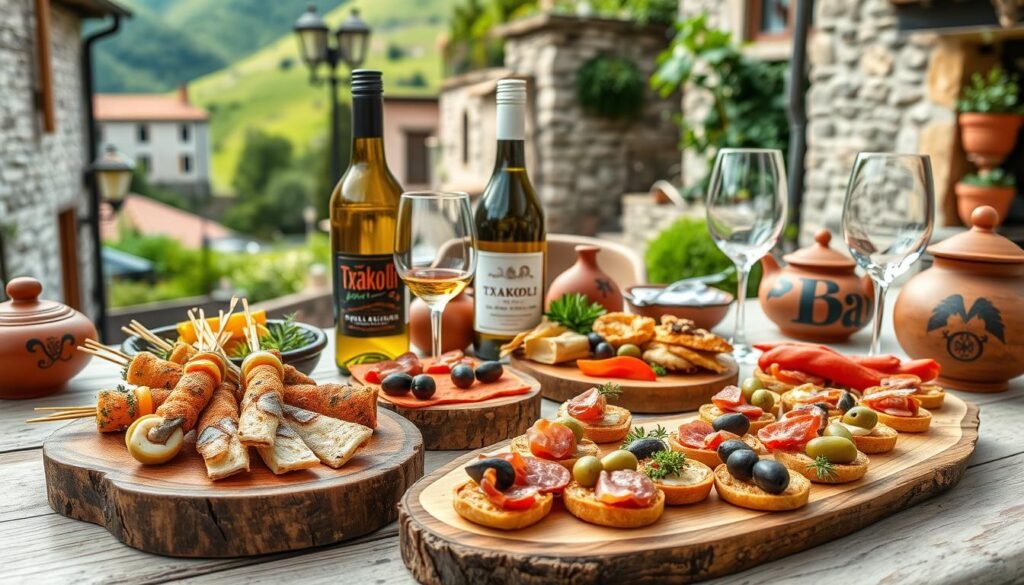
The Basque Country is a food lover’s dream. It’s between the Pyrenees Mountains and the Cantabrian Sea. This place is famous for its Michelin-starred restaurants and rich food history.
At the center of it all are the Pintxos. They are like tapas but from the Basque region. You’ll also find the cool Txakoli wines here.
Pintxos are small and tasty. They have everything from creamy Idiazábal cheese to crispy fried croquettes. You’ll also find salty anchovies and shrimp. Enjoy them with Txakoli wines for the best taste.
The Basque Country has more than just pintxos. You’ll love the marmitako fish stew and ttoro fisherman’s soup. Don’t miss the big Basque txuleton steak, aged for 21 days.
“The Basque Country’s culinary scene is a harmonious blend of tradition and innovation, where the local ingredients and time-honored techniques create an unforgettable dining experience.”
Visiting the Basque Country is a food adventure. You’ll see bustling markets and farms. You’ll also get to try seasonal foods and learn cooking secrets.
La Rioja: Bold Wines and Hearty Flavors

La Rioja is a special place. It’s near the Cantabrian Mountains and the Ebro River. Here, you’ll find amazing Tempranillo grapes and strong La Rioja Wines. But, it’s also famous for its La Rioja Cuisine.
This cuisine mixes Riojan-style Dishes with Hearty Mountain Cuisine. It’s a perfect blend.
Peppers are big in La Riojan cooking. You’ll see them in salads and stuffed peppers. Pimiento relleno and caparrones are favorites. They’re great for the cool mountain weather.
Artichokes and asparagus are also stars in La Riojan food. The Blanca de Tudela artichoke and asparagus from the Cidacos Basin are top-notch. They’re used in dishes like vegetable menestra.
| Signature Riojan Dishes | Key Ingredients |
|---|---|
| Patatas a la Riojana | Potatoes, onions, tomatoes, chorizo, peppers |
| Bacalao a la riojana | Salted cod, peppers, onions, tomatoes |
| Pochas con codornices a la Riojana | White beans, quail, peppers, onions |
The La Rioja Cuisine is amazing. It’s matched with the famous La Rioja Wines. These wines, made from Tempranillo Grapes, Garnacha, and Graciano, pair well with the hearty dishes of La Rioja.
“The essence of La Rioja is found in the marriage of its bold, structured wines and the deeply comforting, vegetable-centric dishes that have been passed down through generations.”
Catalonia: Avant-Garde Cuisine Meets Tradition
Catalonia is a special place by the Mediterranean Sea. It mixes new and old in its food. Barcelona, a top city in Europe, is known for its new food ideas. But, the old food traditions in Catalonia are still loved.
The food in Catalonia comes from the sea and the land. Seafood like prawns and squid are big in local dishes. Herbs like rosemary add a special taste. The slow cooking and rich sauces show the French and local touches.
Calçots: The Quintessential Catalan Onion Celebration
Calçots are a key part of Catalan food. These green onions are grilled until they’re black. They’re served with romesco sauce at calçotadas, a big tradition.
“Catalonia’s cuisine is a tapestry of flavors, weaving together the bounty of the sea, the richness of the land, and the innovative spirit of its culinary masters.”
In Barcelona, the markets smell of fresh food and seafood. The calçotadas in the countryside show the mix of new and old in Catalonia’s food.
Regional Spanish Cuisines: A Tapestry of Tastes
Spain’s food is a mix of many flavors and traditions. From Galicia’s seafood to La Rioja’s red wines, each area has its own taste. This is because of the land, farming, and culture.
The coast has lots of fresh seafood. The land has meat, fruits, and dairy. Cooking over wood and slow stews add special flavors. This mix of land and sea shows the true taste of Spanish gastronomy.
In 2024, 15 places in Spain got Three Michelin Stars. Disfrutar in Barcelona and Noor in Córdoba are among them. This shows Spain’s top culinary excellence.
New food spots in Spain are growing, as seen in the Michelin Guide. Spring and fall are best to visit for food. The weather is nice, and you can try many regional cuisines without crowds.
Food events like La Tomatina and Madrid Fusión show Spain’s love for food. Young chefs are starting their own places. This is changing Spain’s gastronomic identity.
Spain’s food ranges from seafood to stews and new dishes. It shows the diversity of Spanish cuisine. The regional food specialties, traditional cooking methods, local ingredients, and cultural influence all play a part.
Central Spain: Heartwarming Stews and Roasted Delicacies
In the heart of Spain, a beautiful landscape awaits. It’s filled with traditions and tasty foods. From Castile’s plateaus to La Mancha’s hills, the flavors are rich and varied. Here, you’ll find meaty dishes, hearty stews, and famous Castilian roast lamb.
Castilla y León: A Carnivore’s Delight
Castilla y León loves meat. It’s a place where meat lovers find joy. You’ll taste Morcilla de Burgos (blood sausage), cochinillo (roast suckling pig), and lechazo (roast lamb). The cocido maragato stew is a mix of bacon, lamb, duck, and legumes, showing off the region’s cooking skills.
Central Spain also loves Cocido Madrileño, a stew from Madrid. It’s made with pork, beef, and veggies. Each ingredient adds to the stew’s rich flavor.
“The Castilian roast lamb is a true masterpiece, exhibiting the region’s commitment to time-honored techniques and the finest local ingredients.”
Central Spain is all about meat-centric dishes and traditional stews. From Castilla y León’s savory dishes to Cocido Madrileño, it’s a journey for your taste buds. It’s a place that feeds both body and soul.
Andalusia: Tapas, Gazpacho, and Coastal Treasures
In Andalusia, Southern Spain, the food is amazing. This place is full of flavors thanks to its Moorish past and lively cities. You’ll love the gazpacho and the seafood, showing off the area’s history and nature.
Tapas in Andalusia are a big deal. People enjoy small plates like jamón ibérico and pescaito frito. They go great with sherry from Jerez.
Tuna: The Prized Catch of Southern Spain
Cádiz and Huelva are famous for their seafood. Red tuna is a big deal here. You can try it in atún encebollado or ventresca de atún. The tuna is always fresh because of the nearby seas.
“Andalusia’s culinary landscape is a tapestry of flavors, where the sea and the land converge to create dishes that are both comforting and captivating.”
Andalusia also has lots of fresh veggies. Gazpacho, a cold tomato soup, is a favorite. And espinacas con garbanzos shows off the local ingredients.
Exploring Andalusia, you’ll see its food is special. It’s a mix of sea and land flavors. Tapas and seafood make it a feast for your senses.
Conclusion: A Culinary Journey Through Spain’s Regions
Thinking about Spain’s food, I feel very grateful. The diversity of Spanish cuisine shows the country’s rich culture. Each area, from Andalusia’s beaches to the Basque Country’s mountains, has its own food story.
This trip showed me Spain’s love for food. I learned about dishes like paella and gazpacho. It’s a celebration of Spain’s food culture.
Ending this trip, I love Spain’s food even more. It’s amazing how Spain mixes old traditions with new ideas. This journey made me want to try more of Spain’s delicious foods.

